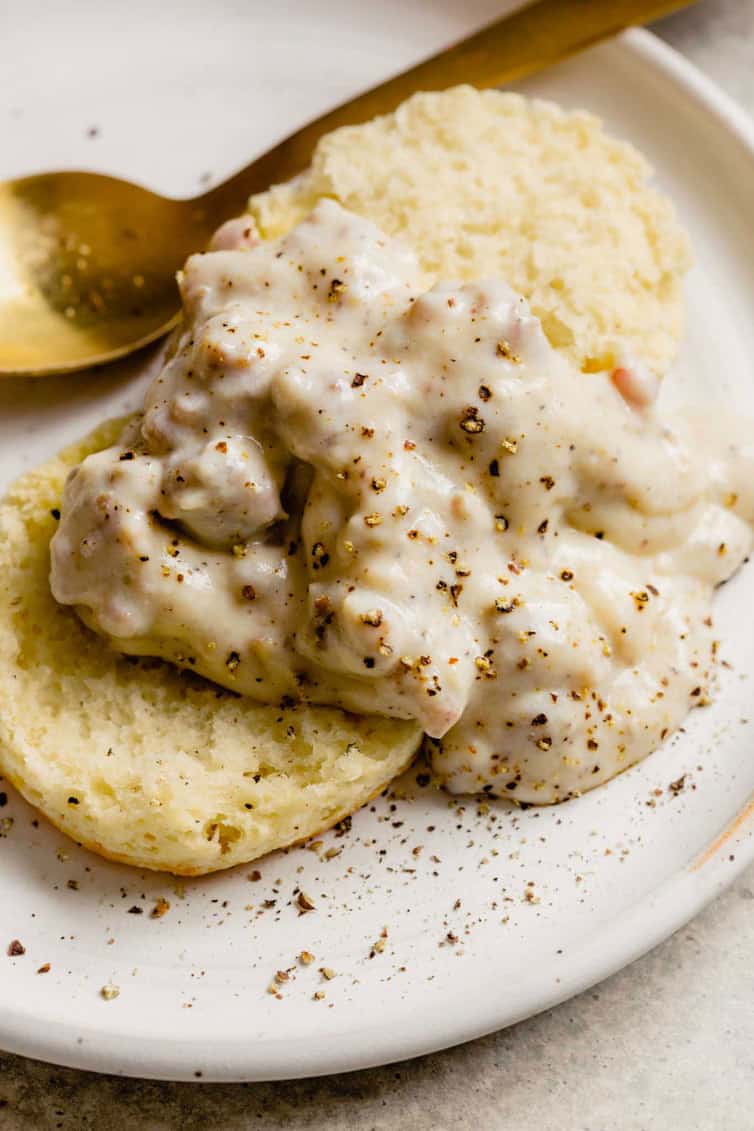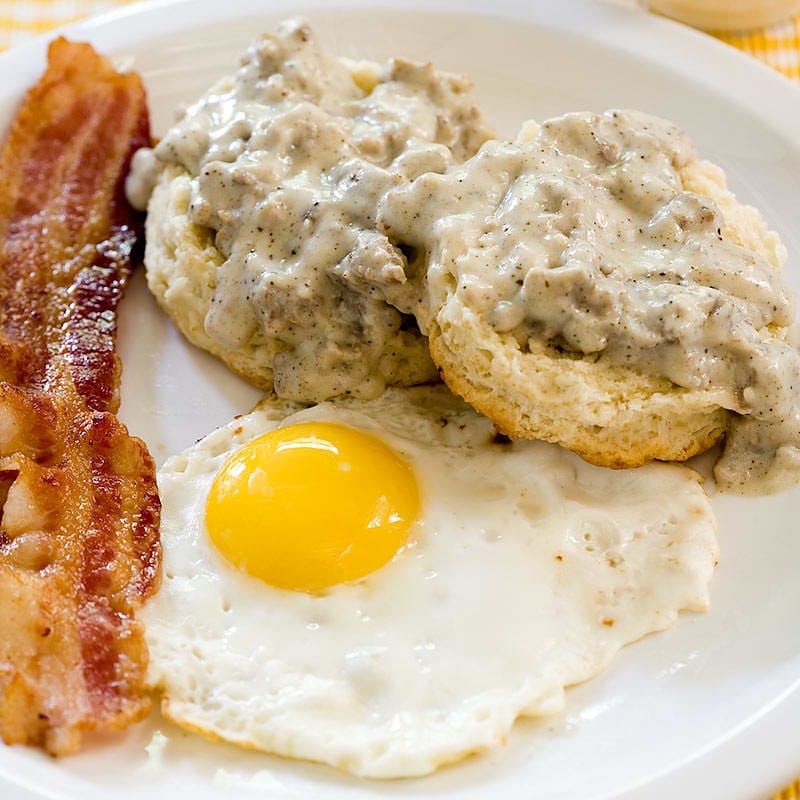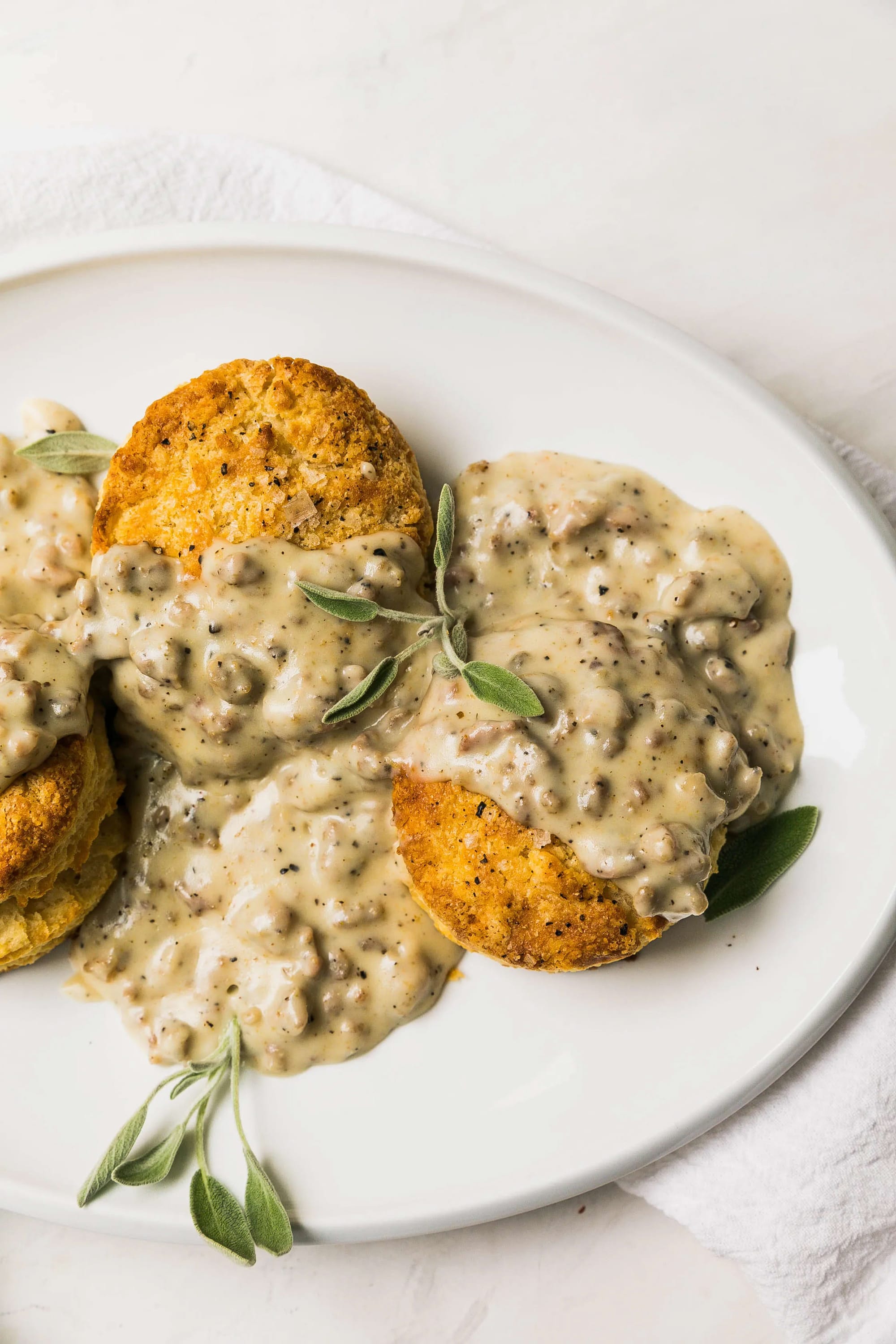Buttermilk Biscuits and Sausage Gravy
There’s something almost magical about breaking open a warm, flaky buttermilk biscuit and watching steam escape before drowning it in creamy sausage gravy. This isn’t just breakfast – it’s a Southern tradition that deserves a spot on your table any time of day. The combination of buttery, layered biscuits with rich, peppery gravy studded with savory sausage creates comfort food at its absolute finest.

What makes this recipe special is the technique for creating truly flaky biscuits (the folding method is a game-changer) paired with a gravy that’s silky-smooth yet packed with flavor. The buttermilk adds a subtle tang that balances the richness, while the sausage brings just the right amount of savory depth. Trust me – once you master this classic combo at home, you’ll never look at restaurant versions the same way again.

Ingredients

For the biscuits:
- 2 cups (240 grams) all-purpose flour
- 1 tablespoon baking powder
- ½ teaspoon baking soda
- ½ teaspoon coarse salt
- 6 tablespoons (85 grams) unsalted butter, cold and cut into cubes
- ¾ cup (170 grams) buttermilk, chilled, plus additional for brushing
For the gravy:
- 8 oz (225 grams) ground country/bulk breakfast sausage
- 2 tablespoons butter
- ¼ cup (30 grams) all-purpose flour
- 2½ cups (568 grams) whole milk (preferred, or 2%)
- 1 teaspoon salt, plus more to taste
- ½ teaspoon fresh ground pepper, plus more to taste

Steps

To make the biscuits:
- Preheat oven to 400°F (205°C). Line a sheet pan with parchment paper to prevent sticking and make cleanup easier.
- In a medium bowl, thoroughly mix together the flour, baking powder, baking soda, and salt. Add the cold butter cubes and cut them in with a pastry cutter or fork until the mixture resembles coarse meal with pea-sized bits of butter still visible – these butter pieces are crucial for creating flaky layers.
- Pour in the chilled buttermilk and stir just until the dough starts to come together. It should look very dry and shaggy at this point – resist the urge to add more liquid as overworking will make tough biscuits.
- Turn the dough out onto a clean, lightly floured surface. Gently gather and knead the dough just until it comes together and all dry bits are incorporated – no more than 8-10 kneads to avoid developing gluten.
- Pat the dough flat to about 1 inch thick, then fold it in half like closing a book. Rotate the dough 90 degrees, flatten again, and fold once more. Repeat this process 2-3 more times – this folding technique creates distinct layers that will puff up during baking.
- Pat the dough again to about 1 inch thick. Using a lightly floured 3-inch round cutter, cut straight down without twisting (twisting seals the edges and prevents rising). You should get about 8 biscuits total, gathering scraps gently to cut the final few. Place biscuits on the prepared baking sheet 2 inches apart, then brush tops with additional buttermilk for better browning.
- Bake until the tops are golden brown, about 15-20 minutes. Look for a significant rise and light golden color. Transfer to a wire rack to cool slightly – but these are best served warm!
To make the gravy:
- While the biscuits are baking, prepare the gravy. In a large skillet set over medium-high heat, brown the sausage, breaking it into crumbles with a wooden spoon. Cook until no pink remains and edges are starting to crisp, about 5-7 minutes. Transfer browned sausage to a paper towel-lined plate to drain, leaving the flavorful grease in the skillet (you can drain some if there’s excessive fat).
- Reduce heat to medium-low and add butter to the pan drippings. Once melted, sprinkle in the flour and whisk continuously to create a smooth roux (paste). Cook for 1-2 minutes to remove the raw flour taste while stirring constantly to prevent burning.
- Very slowly add the milk while whisking constantly to prevent lumps from forming. Use the whisk to scrape the bottom of the pan, incorporating all the browned bits (fond) for maximum flavor. Add salt and pepper.
- Bring the gravy to a gentle boil, then reduce to a simmer and cook until thickened, stirring frequently, about 5 minutes. The gravy should coat the back of a spoon but still be pourable. Return the cooked sausage to the gravy and adjust seasoning with additional salt and pepper as needed.
- Split warm biscuits in half and ladle the hot gravy generously over them. Don’t worry if the gravy seems slightly thin – it will continue to thicken as it cools, reaching perfect consistency by the time you’re ready to eat.
- Store leftover gravy in an airtight container in the refrigerator for up to 5 days. Keep biscuits in an airtight container at room temperature for up to 3 days. Reheat gravy gently on the stovetop with a splash of milk to restore proper consistency.

Smart Swaps
- Use whole wheat flour for up to half the all-purpose flour in the biscuits for added nutrition (may need 1-2 extra tablespoons of buttermilk)
- Substitute unsweetened almond milk for regular milk in the gravy for fewer calories (the gravy won’t be quite as rich but still delicious)
- Try turkey or chicken sausage instead of pork for a lighter option with less fat
Make It Diabetes-Friendly
- Replace all-purpose flour with ½ cup almond flour + ½ cup oat flour + 1 cup all-purpose flour in the biscuits to reduce carbs by approximately 8g per serving
- Use unsweetened almond milk instead of whole milk in the gravy to cut carbs by about 6g per serving
- Portion control is key: enjoy one open-faced biscuit half with ¼ cup gravy (approximately 22g carbs total)
- Add 1 tablespoon ground flaxseed to the biscuit dough to increase fiber, which helps slow glucose absorption
Pro Tips
- Keep your butter and buttermilk ice cold until the moment you use them – this creates steam pockets during baking for maximum flakiness
- When cutting biscuits, press straight down and don’t twist the cutter, which can seal the edges and prevent proper rising
- For extra-flavorful gravy, add ¼ teaspoon dried sage and a pinch of nutmeg along with the salt and pepper
- The gravy will continue to thicken as it cools, so remove it from heat when it’s slightly thinner than your desired final consistency